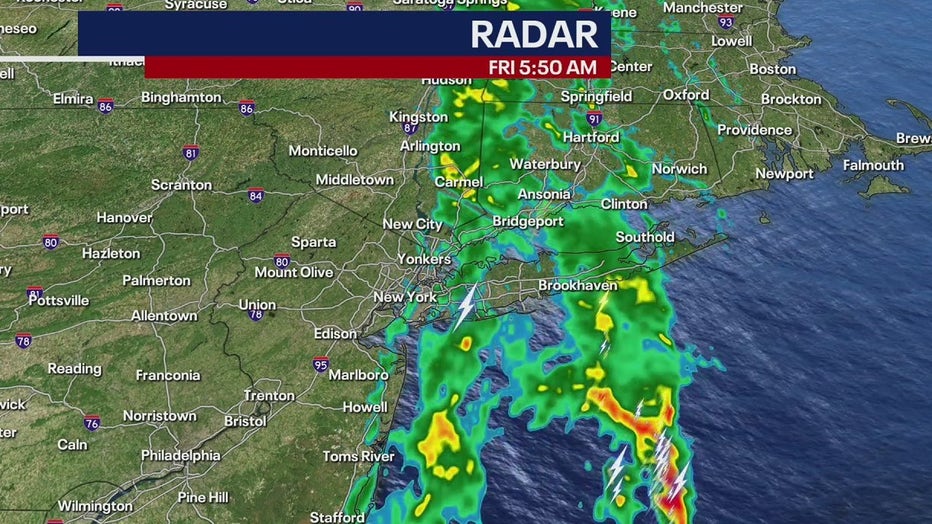Drenching rain making its way out of NYC region

Weather Forecast
Meteorologist Mike Woods says after a drenching rain overnight, the showers are slowly moving out of the region. Skies drying out later. High: 71.
NEW YORK - Flooding concerns appear to be abating as the heaviest rain from a series of storms has moved through most of the tri-state area. A travel advisory is in effect through Friday for the city.
Flash Flood Warnings have been lifted, but Flash Flood Watches are still posted for New York City, northeastern New Jersey, and the Hudson Valley.
A total of 1-2 inches of rain is possible for most of the region. Maximum rainfall rates are forecasted to potentially reach one inch per hour. More than three inches could fall in some spots.
Get breaking news alerts in the free FOX5NY News app! | Sign up for FOX 5 email newsletters
Winds from the southeast will help to feed the storm.
Excessive runoff from rainfall may cause flooding of urban areas, highways, streets, underpasses, as well as other poor drainage or low-lying spots.
Exercise caution when traveling. Do not drive your vehicle or walk into areas where water covers the roadway as the water depth may be too great to allow you to cross safely. Use mass transit if possible.
If you lose power and have a disability or access needs, or use life-sustaining equipment and need immediate assistance, dial 911

If you live in a basement apartment, be prepared to move to a higher floor during periods of heavy rain.
Parts of the region are still recovering from a catastrophic storm with severe flooding earlier this month that took the lives of dozens of people in the region.
RELATED: President Biden surveys storm damage in New Jersey and Queens
"The City is still working to recover Ida, and we want to ensure that New Yorkers are ready. New Yorkers should prepare for possible thunderstorms that can cause strong wind gusts and moderate rainfall," NYC Emergency Management Commissioner John Scrivani said. "New Yorkers should give themselves additional travel time and take the appropriate precautions if they must move about the city during the storm."
Safety Tips from the Office of Emergency Management
- If you live in a basement apartment, be prepared to move to a higher floor during periods of heavy rain.
- If you live in a flood-prone area, keep materials such as sandbags, plywood, plastic sheeting, and lumber on hand to help protect your home.
- If you have a disability or access or functional need, make sure your plan addresses how your needs may affect your ability to evacuate, shelter in place, or communicate with emergency workers. Arrange help from family, friends, or service providers if you will need assistance.
- Exercise caution when traveling. Do not drive your vehicle or walk into areas where water covers the roadway as the water depth may be too great to allow you to cross safely. Use mass transit if possible.
- When outside, avoid walking and driving through flooded areas. As few as six inches of moving water can knock a person over. Six inches of water will reach the bottom of most passenger cars, causing loss of control and possible stalling. One or two feet of water can carry away a vehicle.
- Stay out of any building if it is surrounded by floodwaters. Avoid flooded subway stations.
- If you see downed electrical wires, do not go near them. Never attempt to move or touch them with any object. Be mindful that tree limbs, leaves, or water can cover downed wires from view. Always stay away from downed power lines because they could be live.
- Strong winds can bring down trees and power lines and can turn unsecured objects into dangerous projectiles. They can also cause power outages. To prepare for these hazards, New Yorkers should: Check the area immediately surrounding your home for unsecured objects or potentially dangerous conditions. Tree limbs, garbage cans, yard debris, or other materials that can be moved by the wind are potential projectiles aimed at your home or parked vehicle. Bring inside loose, lightweight objects such as lawn furniture, potted plants, garbage cans, garden tools and toys.
- Check the area immediately surrounding your home for unsecured objects or potentially dangerous conditions. Tree limbs, garbage cans, yard debris, or other materials that can be moved by the wind are potential projectiles aimed at your home or parked vehicle.
- Bring inside loose, lightweight objects such as lawn furniture, potted plants, garbage cans, garden tools and toys.
- Report downed wires immediately. If a power line falls on your car while you are in it, stay inside the vehicle and wait for emergency personnel.
Power Outages
- To prepare for a possible power outage, charge cell phone batteries, gather supplies, and turn your refrigerator and freezer to a colder setting. If you lose power, items that need refrigeration will stay cooler for longer.
- Make sure your flashlights and any battery-operated radios or televisions are working. Keep extra batteries.
- If you lose power and have a disability, access and functional needs or use life-sustaining equipment (LSE) and need immediate assistance, dial 911.
- Do not use generators indoors.
- Check on friends, relatives, and neighbors, especially older adults and people with disabilities, access and functional needs, or health conditions. Help them to prepare if needed.
Download the FREE Fox 5 NY weather app and always stay updated on storms.
Apple App Store: https://apple.co/2GrlPnz Google Play Store: http://bit.ly/2IPSlTd
Fox 5 Weather Team on Twitter
- Nick Gregory @NickGregoryFox5
- Mike Woods @MikeWoodsFox5
- Audrey Puente @AudreyPuente
- Raegan Medgie @RaeganMedgie

